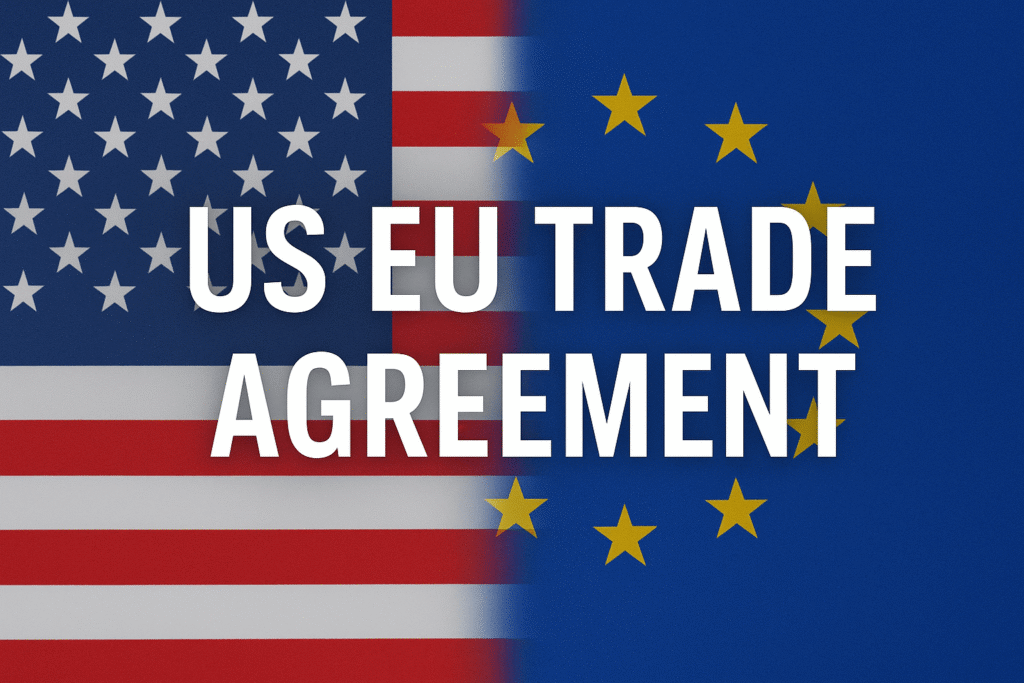
In a historic move, the US EU trade agreement has redefined global trade landscapes, marking a significant victory for the Trump administration. After weeks of intense and often tense negotiations, Washington and Brussels reached a pivotal consensus. The timing of this development, just before the upcoming US China tariff talks amplifies its global impact.
One important factor was the direct engagement of President Donald Trump. Once again, his hands-on approach to diplomacy delivered what analysts now call one of the most influential trade deals of the year. The Trump trade deal 2025 isn’t just a symbolic handshake it carries weight in policy, economy, and international power alignment.
The European Union narrowly dodged a severe 30% tariff threat with this accord, opting instead for a 15% U.S. tariff on several key exports. While the compromise isn’t ideal for Brussels, it offers much-needed clarity and relief for European automakers and steel exporters.
This EU US trade news is already shaking financial markets and policy circles. The deal provides predictability in a volatile economic environment and signals a clear shift in how the U.S. intends to handle its international trading partners under Trump’s renewed economic agenda.
Trump’s Trade Strategy: A Calculated Step Before Engaging China
The US EU trade agreement serves as a strategic milestone as Trump prepares for the next major challenge US China tariff talks. Analysts believe that by resolving disputes with Europe first, the U.S. strengthens its negotiating position against Beijing.
The EU has committed to buying more than $600 billion worth of U.S. products, including military equipment and energy exports. That not only boosts the U.S. economy but also solidifies transatlantic alliances, something Trump views as crucial in his broader Trump-EU negotiation strategy.
“President Trump is sending a message: the era of unbalanced trade is over,” said a senior White House advisor. “We’re done playing defense. This is about America leading again in global commerce.”
For Europe, the timing couldn’t be more critical. Sluggish growth and internal political fragmentation had weakened the EU’s bargaining position. Still, negotiators managed to secure a reduced tariff rate and maintained access to the U.S. market for essential exports like automobiles, machinery, and agricultural goods.
Trump’s critics argue that his methods risk alienating key allies, but the numbers speak for themselves. Based on last year’s data, the global trade agreement could generate $90 billion in additional revenue for the U.S. Treasury through tariffs alone.
The US tariffs on Europe remain controversial, especially the 50% duty still imposed on steel and aluminum. However, Trump insists it’s a necessary step to protect American manufacturing and prevent unfair competition. “We’re not backing down,” he said during a press briefing. The EU has committed to buying more than $600 billion worth of U.S.
Trade War Update: What This Means for the World Economy
This trade war update reveals a world in transition. The US EU trade agreement isn’t just a bilateral win it’s a signal that the U.S. is taking control of its economic future. While the EU had to make concessions, leaders in Brussels framed the deal as a step toward sustainability and cooperation.
Ursula von der Leyen, president of the European Commission, acknowledged that rebalancing was necessary. “We have strong trade ties,” she said, “but we must ensure they are fair and durable. This agreement helps us move in that direction.”
What makes this deal even more impactful is its ripple effect. It follows closely after trade agreements with Vietnam, Japan, and the United Kingdom all of which sought to position the United States as the hub of a new, equitable trading system. Next up are discussions with China, Canada, and Mexico. The world watches with anticipation.
If the US China tariff talks succeed, the global economy could see a surge in stability and investment. But failure could bring a wave of uncertainty, inflation, and disrupted supply chains.
The US EU trade agreement acts as a stabilizer in this storm. It reassures businesses, investors, and policymakers that progress is still possible even in a deeply polarized world.
A Defining Moment in Modern Trade
This agreement stands as a monumental step forward in reimagining America’s place in global economics. It combines policy strength, strategic timing, and presidential leadership. More importantly, it reflects Trump’s long-standing belief that U.S. trade partners must respect reciprocity over routine.
As the dust settles, one thing becomes clear: The US EU trade agreement is not just about tariffs or exports it’s about reclaiming economic sovereignty. And with Trump’s trade deal 2025 now in place, the United States appears ready to lead the next chapter in global trade.
